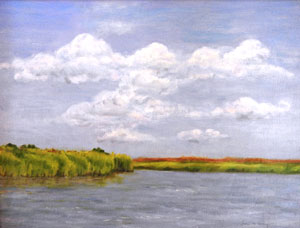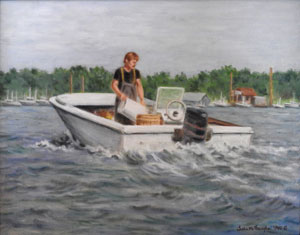Maurice River Township: The Gateway to the Wild and Scenic Rivers

Maurice River Township, bounded by its namesake to the west and gently lapped by the Delaware Bay to its south, is truly unique. Of its 94.7 square miles, 66 are within the state's Pinelands Protection Area, home to many threatened and endangered Pine Barrens plants and animals.
Its four rivers: the Maurice, the Menantico, the Manumuskin, and the Muskee Creek; boast outstanding beauty and unparalleled recreational opportunities. They were recently recognized by the National Park Service and Congress as a national treasure and are now included in the Federal Wild and Scenic Rivers Program.
Long ago, aboriginal hunters and gatherers lived by our rivers and creeks.
A 4 to 6 thousand-year- old village site, discovered on the Maurice near
Port Elizabeth, is part of our rich archeological heritage. The Maurice River
(pronounced "Morris") took its present name from the Prince Maurice, a
Dutch ship which was set ablaze and sunk by Indians below Mauricetown.
Settled by Swedes in the early 1700's, Maurice River Township quickly
developed grist and sawmills along the tributaries, as well as bog iron
furnaces and forges. Riverside farms were created by diking the tidal
wetlands with high earthen embankments. In the 19th century,
glassmaking and shipbuilding became major industries, along with coastal
trading and oystering.

Dorchester and Leesburg were developed with shipbuilding as their principal industries. Port Elizabeth was established earlier, around 1780, by Elizabeth Bodly. A flourishing commercial center, it was designated the port of delivery for its region by an act of Congress in 1789, and remained the hub of the West Indies trade until Philadelphia and New York surpassed it in the early 19th century. In 1830 Maurice River Township had the largest population of the county's eight municipalities; by 1865 its heyday was over.
Currently Maurice River Township's major industries are resource extraction and water-based activities. Marinas dot the shoreline of the Maurice from Spring Garden down to Matt's Landing. Watermen, including crabbers and oystermen, make their living from the Maurice and the Delaware Bay as their forefathers did years ago. Commercial and sports fisherman together with recreational boaters share the bounty of weakfish, flounder, and blues, and a shipyard carries on the local boat-building tradition.

In addition, Maurice River Township's unspoiled woods, meadows, creeks and marshes offer unparalleled opportunities for passive recreation such as hiking, camping, canoeing, art, photography, and birding. The Delaware Bay towns of Moore's Beach, Thompson's Beach, and East Point are excellent sites to view the globally significant shorebird migration in the spring. Over 1.5 million birds, some arriving non-stop from South America, congregate to feast on the annual horseshoe crab egg banquet laid out on the sandy beaches of the Bay. In addition, the Maurice River hosts large numbers of bald eagles; in the winter as many as 16 individuals have been counted in one day. According to the Birding Guide to Cumberland County, many of the area's richest habitats occur in Maurice River Township, easily accessible by car. For the artist and history buff the often-painted East Point Lighthouse, built in 1849 and the last remaining lighthouse on the Delaware Bay, is also well worth seeing, With its rivers, marshes, meadows, and breathtaking sunsets, Maurice River Township offers a special environment indeed to the visitor.
